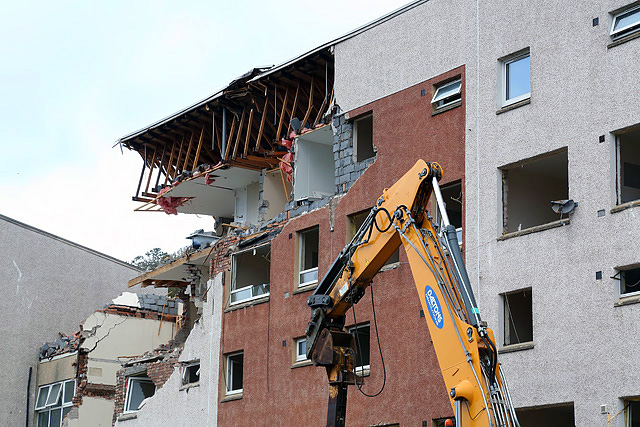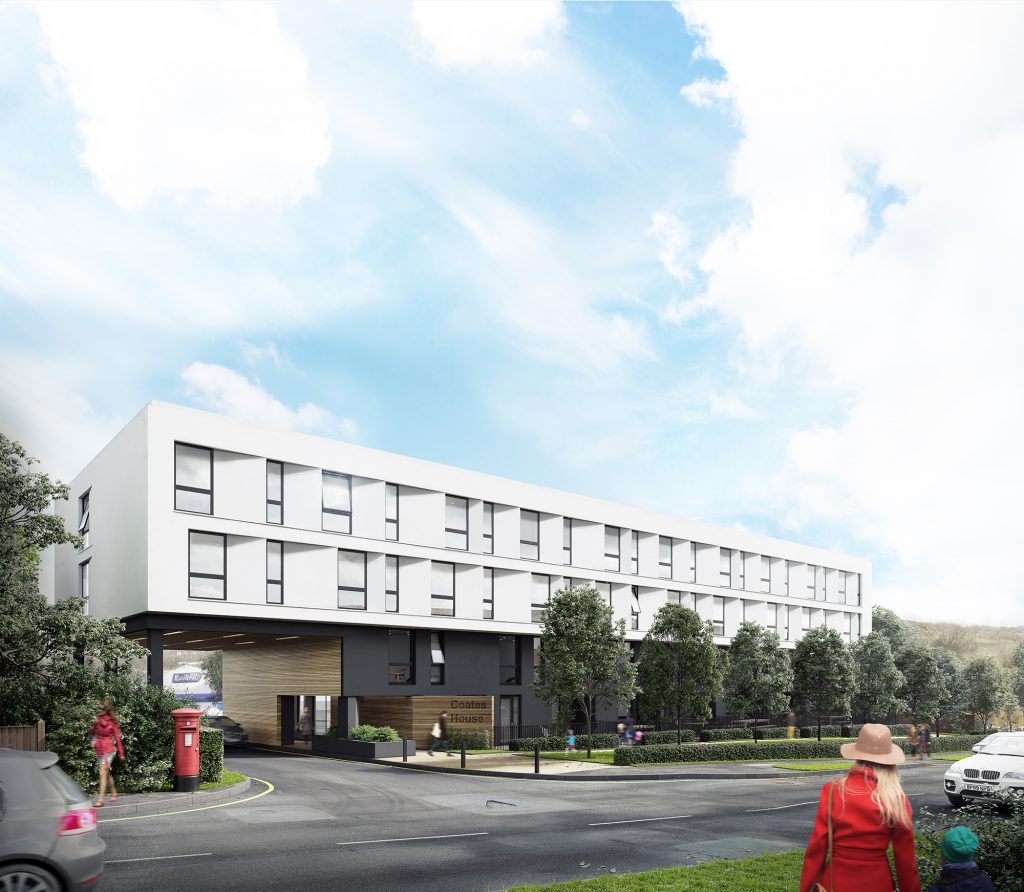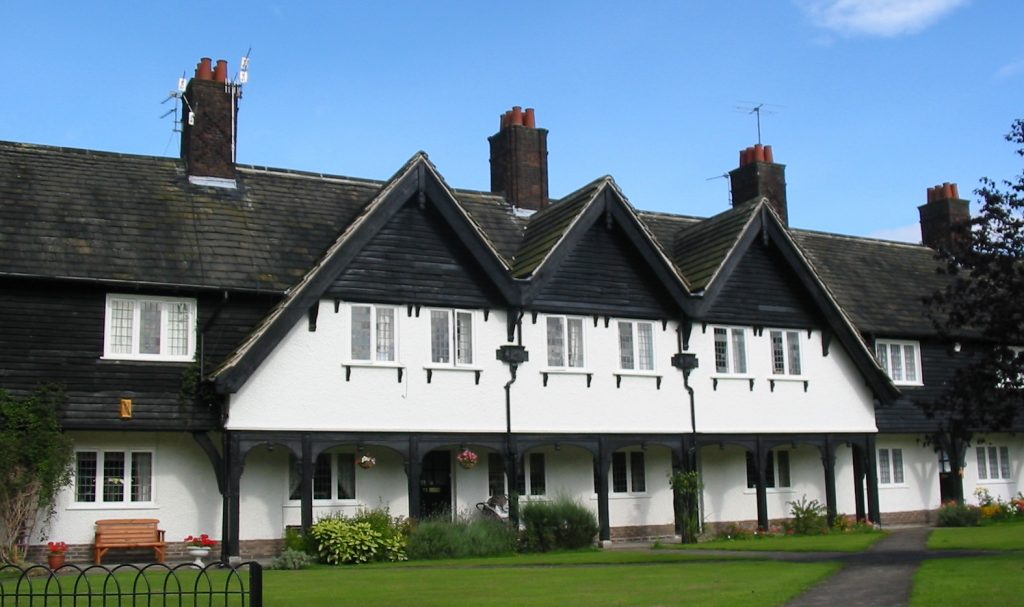Lets solve the real housing crisis

How long do you think your house was designed to last? Let me put it another way. When do you think your house will be demolished? Houses get replaced when it is cheaper to replace them than it is to maintain them or, put another way, when more money can be made by knocking them down. So when will it be time-up for your home? Consider this, would you knock your house down if the roof finish or kitchen needed replacing? Probably not. Like the ship Ergo, all the parts might be slowly replaced but the ship remains. What about when it no longer meets your requirements? No doubt you would move or extend, assuming the banks will still let you borrow against the value of your increasingly tired home. What about if the roof, facade, kitchen, carpets, decoration and heating all needed replacing at the same time? It would not make economic sense at that point, particularly with the VAT added on top. Now you might well consider knocking it down, or a developer certainly would. The only thing stopping you would be how much you love your old house. We are seeing homes built as recently as the 1970’s being replaced. This is potentially a big problem.
Our concern is that we are not currently solving a crisis, we think we may still be busy creating one. Let us explain why. The true crisis facing modern housing is this; our houses are not built to last. When speed, cost cutting and skin deep branding define value we won’t create a product that lasts. Why is this a #housingcrisis ?

Where I grew up in the Congo, you and your neighbours could build a house over a long weekend. It was a basic mud hut, but it was fit for purpose, cost next to nothing and was cheap to maintain. You might need to build yourself a new house every 15 years but that required very limited resources, so no problem. The rate of production easily kept up with the rate of replacement. In the UK things are very different. For starters our houses are much better quality (or so we like to think) but, our houses also take many skilled and less skilled workers over two years to build, once the full development process is taken into account. They also cost around 30% of our lifetime income and take around 30% of our life to pay off. So what you might say.
Let’s look at the big picture. There are approximately 25M houses in England. Since the 1950's we have been adding around 220,000 houses to the housing stock annually and in 2016/17 we build 227,000, including 37,000 conversions, largely under permitted development. House building peaked at 350,000 homes annually in the mid 1930's and 1960's. This is the past but how many houses do we need to build in the future?
Dr Alan Holman's research at Cambridge University suggests that we need 240,000 houses each year to meet the increasing number of new households. Critically, this figure excludes any reductions in the housing stock. How many additional houses might we need to built to exceed the replacement rate? There is very limited data and no apparent consensus on the rate of replacement. In the past, during times of slum clearance it has been as high as 100,000/year. Records suggest that around 21,000 houses where removed from the housing stock annually in the 1980's and since 2006/07 this has been steadily falling from 22,000 down to just under 10,000 in 2016/17. This would, on the surface, look to be good news but, with replacement rates so low few people seem to be focusing on the need to consider what affect replacing houses will have on targets. The vast majority of our housing stock is still relatively young, with around 50% built in the past 50 years. Saltford Manor is the oldest house in Britain, which dates from the 11th Century, but this is clearly a rarity. What history shows is that many houses don't last anywhere near this long! What then should be the assumed rate of replacement?
The current rate of 10,000 houses being demolished annually would suggest a replacement rate of 0.04%. On this basis it would take 2500 years to replace all of our current housing stock. I doubt many architects, let alone their developer clients have this duration in mind when they are asked to sign up to 12 years liability! Clearly modern houses are not built to last this long. What then might be a more reasonable assumption looking forward and what are the consequences?
Currently around 21% of the housing stock was built pre 1919 and around just over half between then and the mid 1960’s. This means that over 75% of the housing stock is well over 50 years old and would suggest that a good number of houses will live well over 100 years. On the surface this shows just how long houses can last. These of course are the houses that survived. What is less clear is how many didn't make it. Almost all of this existing housing stock is masonry construction and those that have survived were built to last. Those that weren’t have of course already been demolished.
Our concern is that we are today concerned more with speed than lifespan. Historic rates of replacement are a poor guide to the future. In Britain we love our period properties and, as a result we care for them and they last. The problem comes when we don't love our houses. Sadly it seems we don't love late 20th Century houses as much. It is of note that most demolitions today are of buildings built since the war. The simple truth is this; when we don't love where we live its life expectancy drops dramatically. It seems to us that the rate of replacement, like almost everything else in modern society, is accelerating. We would not go so far as to accuse the construction industry of designed obsolescence but, there is no doubt that modern methods of construction do not come with 2,500 year warranties!
Today we build with materials that are often only given a 15-20 year manufacturer’s warranty. The consequence of this is the economic one we alluded to earlier. All these materials will need to be replaced at approximately the same time. When that time comes, it will, in many cases, make more economic sense to start again. Not least if there is a shortage of land and little or no love for the house itself. Now this may sound like good news for architects like us who specialise in housing and very good news for our developer clients. But is it sustainable?
We don’t think so, even if it were economically viable. The challenge is that the vast majority of our current housing stock was build post war. It seems to us that the 15M homes built since the war are less loved and less robust than the pre-war, predominantly masonry houses that have already survived the test of time. Even if we assume the majority of our post war housing stock were built robustly, it would seem likely that these houses will start to need replacing at a higher rate than is currently being assumed. How then might we establish an appropriate replacement rate?
If, instead of assuming our houses will last for 2500 years we instead assume this to be a more realistic 200 years, the rate of replacement increases to 0.5%. This would require an additional 125,000 houses to be added to the housing target. This is half again on top of current projections. Our fear is it is more nuanced and somewhat worse than this. In our view most houses built since the war will be lucky to survive 100 years. This is primarily because, unlike their pre-war cousins, they are by and large unloved and uneconomical to alter or maintain. If this is the case we could have a 1% replacement rate on the 15M houses built since the war, in addition to the 0.5% rate for the 10M built before. This would require 200,000 houses annually in addition to the 240,000 needed for new households. This total of 440,000 houses is double current targets. This would seem bad enough but sadly this is still not the true measure of the crisis.
What if, in addition to this, it turns that today we building with even shorter lifespans in mind. Modern houses are built in an age of designed obsolescence and with fast construction rather than long life as the goal. When all those warranties expire and modern houses need many of their essential components replacing, and all at the same time, one may well find that all these snazzy new homes might be more economical to replace. Not least with VAT chargeable on refurbishment work! If this is the case we might find ourselves needing to rebuild a far higher proportions of our new housing stock and within as little as 40 years. On this basis we could be required to build as many as 625,000 houses per year just to maintain the housing stock. This is an unsustainable legacy to leave to future generations.
Here then is the true crisis; Our rush to build houses quickly is in danger of creating a scenario where houses are needing replacing faster than we can build them. This will result in a significant number of households becoming homeless. At current rates of construction and on the basis of these projections some 400,000 households a year could be homeless by 2060. Now that is a real crisis.
Before we all break out in blind panic. What can be done? To solve this crisis we must build houses that last, at least a life time and most importantly build above the true rate of replacement. It is a mathematical certainty that to do otherwise is a crisis guaranteed. To solve a crisis you need to know the true source of the problem. Our problem is the same as it has always been; Firmitas, Commoditas, Venustas. This means houses that are cost effective to maintain, able to be adapted to changing circumstances and that are loved. In summary, houses that are built to last and above all, houses that are loved.
Sustainability is the ability to maintain. We must create houses that are easy and cost effective for people to maintain, delaying their replacement. Only then will we ensure our houses last at least one life time and hopefully longer.
What then are some of the solutions? At Snug we are currently repurposing a lot of offices though office to residential conversion. This may double the life of those buildings. They may even make it to their 100th birthday.
Before

After

This is part of the solution but it does not solve the crisis. It is suburban housing that we must tackle. Legislators, planners, designers, lenders and developers must work together to establish a viable approach to the delivery of houses that are built to last. Heaven help us if we don’t.
There is much we can learn from our past. In the Industrial Revolution we built both the good and the bad. The good is still with us, places like the Lever Brothers' workers housing at Port Sunlight. These were places built generously. They have lasted well over 100 years and continue to grow in value, showing no sign of needing replacing. Many others at their time built what quickly became slums. They barely lasted half a life time.

The act of building houses, must become more than a short term economic activity. It must become a generous act and an investment in our collective future; more national infrastructure than asset class. Perhaps we should even be receiving tax breaks for maintaining our homes.
If we can’t expect this through developers own inclinations we must make it in their interest. If those who deliver houses had ownership of the future things might be different. We have found it is always the case that those clients who retain some measure of ownership invest more in quality. We need those who create to have ownership of the consequences. Then they will take responsibility and generosity will become self-interest. The Lever Brothers where no fools. They knew that we reap what we sow. Because they believed this, they built to last and built places that people have loved.
This approach is high cost but long life. There is of course an alternative, we pursue the low cost short life approach of my African friends. This is the other side of the same coin. It is more intense and results in a far higher replacement rate. It is certainly an option but we are not convinced this is something our current, drawn out and highly contested approach to planning, can cope with. We have of course been here before. In the post war housing crisis pre-fab housing saved the day. They may not have been designed to last but of course many have long outlived their design life through tender love and care.

Arcon MK V Pre-fab from 1946.
Whichever approach we take we need to focus on solving the real crisis. By all means lets build fast, we certainly need to build more but, above all, lets build houses that people will love. This above all things will delay their replacement. Perhaps the best example of this is the Great Mosque of Djenne. The current mosque was built in 1907 and despite being made of mud remains in good order. The reason is, it is well loved by the local community. While it is loved, it will last.

We clearly aren’t building enough houses and because we aren't building either to love or to last there is a real danger that we are building well below the rate of replacement. This is a crisis in the making, a crisis we are still busy creating.
To solve the crisis we must focus on the source; we are neither building enough houses or building above the sustainable replacement rate. Our current focus is almost exclusively on building enough houses to meet growing household numbers. Few if any housing targets are accounting for the rate of replacement. It is this challenge we believe our industry must now focus on trying to solve.

